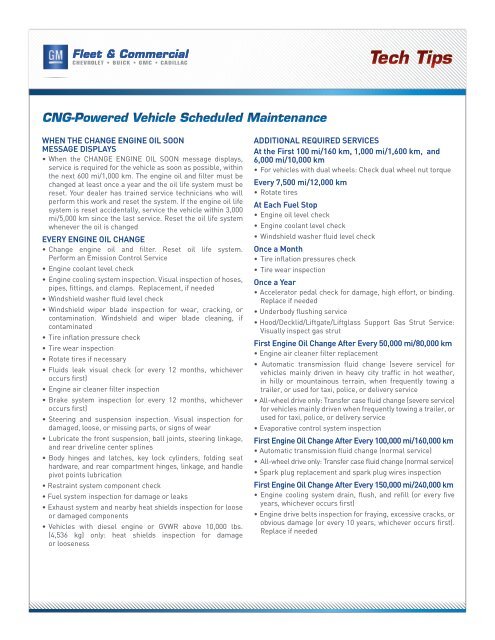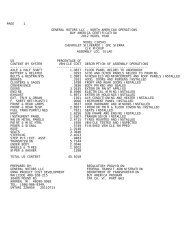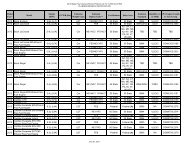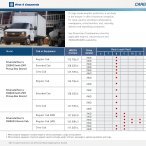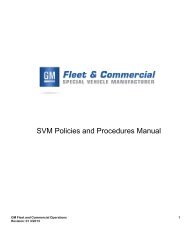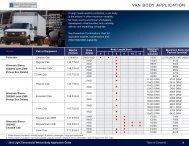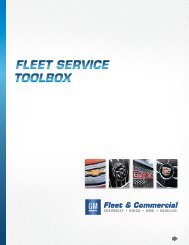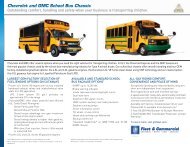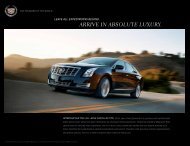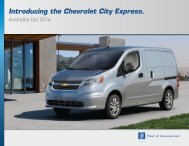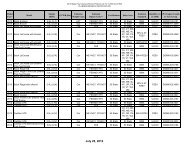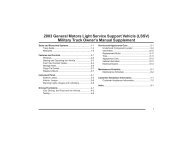CNG-Powered Vehicle Scheduled Maintenance (PDF) - GM Fleet
CNG-Powered Vehicle Scheduled Maintenance (PDF) - GM Fleet
CNG-Powered Vehicle Scheduled Maintenance (PDF) - GM Fleet
You also want an ePaper? Increase the reach of your titles
YUMPU automatically turns print PDFs into web optimized ePapers that Google loves.
Tech Tips<br />
<strong>CNG</strong>-<strong>Powered</strong> <strong>Vehicle</strong> <strong>Scheduled</strong> <strong>Maintenance</strong><br />
When the Change Engine Oil Soon<br />
Message Displays<br />
• When the CHANGE ENGINE OIL SOON message displays,<br />
service is required for the vehicle as soon as possible, within<br />
the next 600 mi/1,000 km. The engine oil and filter must be<br />
changed at least once a year and the oil life system must be<br />
reset. Your dealer has trained service technicians who will<br />
perform this work and reset the system. If the engine oil life<br />
system is reset accidentally, service the vehicle within 3,000<br />
mi/5,000 km since the last service. Reset the oil life system<br />
whenever the oil is changed<br />
Every Engine Oil Change<br />
• Change engine oil and filter. Reset oil life system.<br />
Perform an Emission Control Service<br />
• Engine coolant level check<br />
• Engine cooling system inspection. Visual inspection of hoses,<br />
pipes, fittings, and clamps. Replacement, if needed<br />
• Windshield washer fluid level check<br />
• Windshield wiper blade inspection for wear, cracking, or<br />
contamination. Windshield and wiper blade cleaning, if<br />
contaminated<br />
• Tire inflation pressure check<br />
• Tire wear inspection<br />
• Rotate tires if necessary<br />
• Fluids leak visual check (or every 12 months, whichever<br />
occurs first)<br />
• Engine air cleaner filter inspection<br />
• Brake system inspection (or every 12 months, whichever<br />
occurs first)<br />
• Steering and suspension inspection. Visual inspection for<br />
damaged, loose, or missing parts, or signs of wear<br />
• Lubricate the front suspension, ball joints, steering linkage,<br />
and rear driveline center splines<br />
• Body hinges and latches, key lock cylinders, folding seat<br />
hardware, and rear compartment hinges, linkage, and handle<br />
pivot points lubrication<br />
• Restraint system component check<br />
• Fuel system inspection for damage or leaks<br />
• Exhaust system and nearby heat shields inspection for loose<br />
or damaged components<br />
• <strong>Vehicle</strong>s with diesel engine or GVWR above 10,000 lbs.<br />
(4,536 kg) only: heat shields inspection for damage<br />
or looseness<br />
Additional Required Services<br />
At the First 100 mi/160 km, 1,000 mi/1,600 km, and<br />
6,000 mi/10,000 km<br />
• For vehicles with dual wheels: Check dual wheel nut torque<br />
Every 7,500 mi/12,000 km<br />
• Rotate tires<br />
At Each Fuel Stop<br />
• Engine oil level check<br />
• Engine coolant level check<br />
• Windshield washer fluid level check<br />
Once a Month<br />
• Tire inflation pressures check<br />
• Tire wear inspection<br />
Once a Year<br />
• Accelerator pedal check for damage, high effort, or binding.<br />
Replace if needed<br />
• Underbody flushing service<br />
• Hood/Decklid/Liftgate/Liftglass Support Gas Strut Service:<br />
Visually inspect gas strut<br />
First Engine Oil Change After Every 50,000 mi/80,000 km<br />
• Engine air cleaner filter replacement<br />
• Automatic transmission fluid change (severe service) for<br />
vehicles mainly driven in heavy city traffic in hot weather,<br />
in hilly or mountainous terrain, when frequently towing a<br />
trailer, or used for taxi, police, or delivery service<br />
• All-wheel drive only: Transfer case fluid change (severe service)<br />
for vehicles mainly driven when frequently towing a trailer, or<br />
used for taxi, police, or delivery service<br />
• Evaporative control system inspection<br />
First Engine Oil Change After Every 100,000 mi/160,000 km<br />
• Automatic transmission fluid change (normal service)<br />
• All-wheel drive only: Transfer case fluid change (normal service)<br />
• Spark plug replacement and spark plug wires inspection<br />
First Engine Oil Change After Every 150,000 mi/240,000 km<br />
• Engine cooling system drain, flush, and refill (or every five<br />
years, whichever occurs first)<br />
• Engine drive belts inspection for fraying, excessive cracks, or<br />
obvious damage (or every 10 years, whichever occurs first).<br />
Replace if needed
Tech Tips<br />
<strong>CNG</strong>-<strong>Powered</strong> <strong>Vehicle</strong> <strong>Scheduled</strong> <strong>Maintenance</strong><br />
<strong>CNG</strong> vehicles are designed for routine maintenance (fluids, filters, etc.) according to the original specifications as provided in the<br />
Owner’s Manual for gasoline fuel vehicles. See the Owner’s Manual for maintenance service intervals and fluid specifications.<br />
See your dealer or other qualified repair facility for required service and maintenance. Your dealer has the necessary<br />
training and parts to repair the vehicle.<br />
In addition, the <strong>CNG</strong> system requires the following every 36,000 miles (60,000 km) or 36 months,<br />
whichever occurs first:<br />
• Visual inspection of the <strong>CNG</strong> fuel tanks by a CSA International-certified inspector or authorized <strong>GM</strong> dealer. For more information,<br />
see your dealer or visit: www.csa-international.org<br />
• Have the <strong>CNG</strong> fuel system and tanks inspected if the vehicle has been involved in a collision or fire. The fuel tanks must be<br />
replaced 15 years after manufacture. The expiration date of the fuel tanks is on a label on the fuel tanks and on a warning<br />
label on the fuel filler door. Have an authorized <strong>GM</strong> dealer replace the fuel tanks. Do not reuse old fuel tanks<br />
• Replacement of the coalescent filter. See your dealer<br />
Warning: The tank shields protect the <strong>CNG</strong> tank in a crash and from road hazards. Removal of the shields may result in<br />
tank damage that could result in a rupture or possible explosion of the tank. You or others could be injured or even killed.<br />
If you must remove a tank shield for any reason, e.g., tank inspection or vehicle repair, always reinstall the shield before operating<br />
the vehicle.<br />
Warning: Keeping a <strong>CNG</strong> fuel tank in service after the tank service expiration date is dangerous and is prohibited by federal law.<br />
The tank may no longer withstand the <strong>CNG</strong> fuel system operating pressure. You could be severely injured or killed. Take the<br />
vehicle to an authorized <strong>GM</strong> dealer to have the tank replaced.<br />
Tank Locations<br />
Four-tank<br />
system adds<br />
interior tank<br />
Three-tank<br />
system<br />
underfloor<br />
locations


